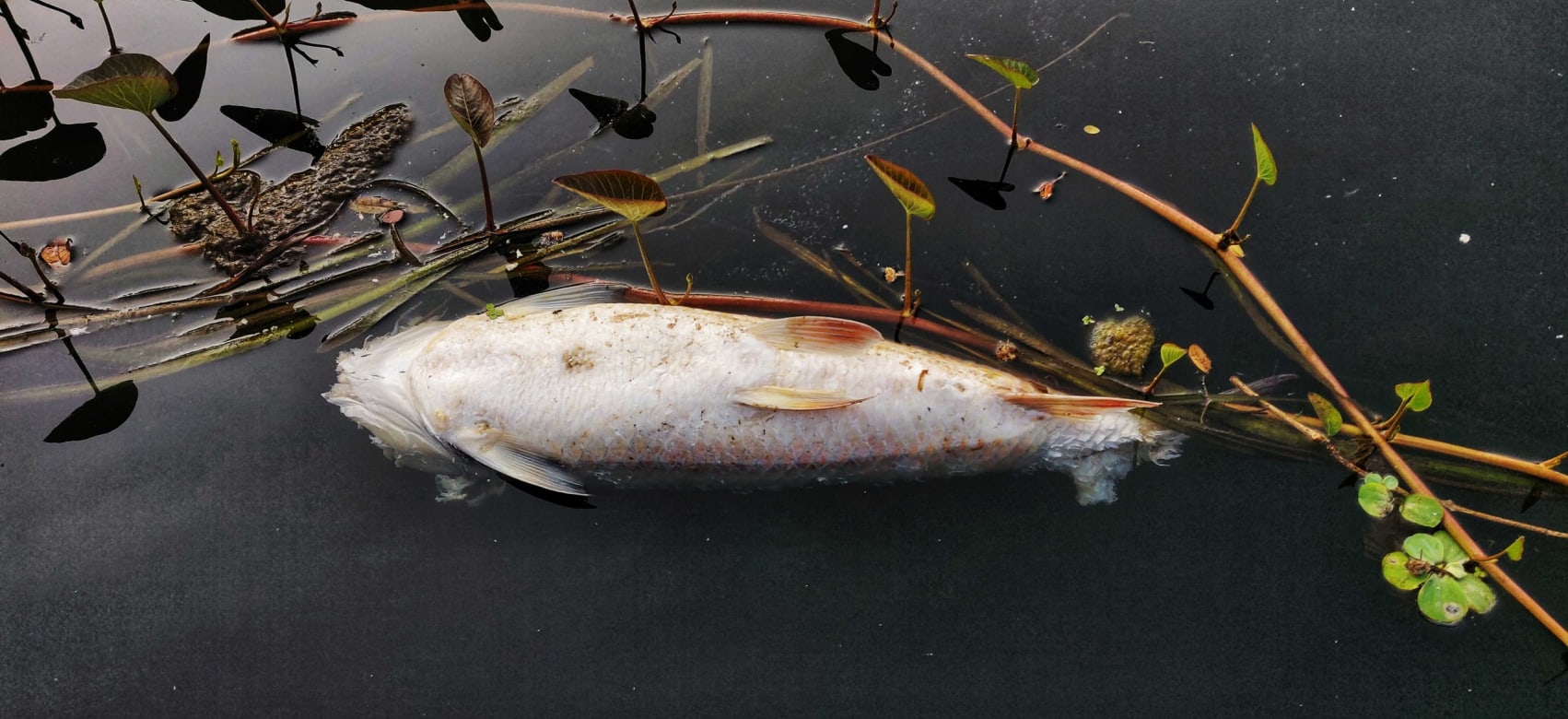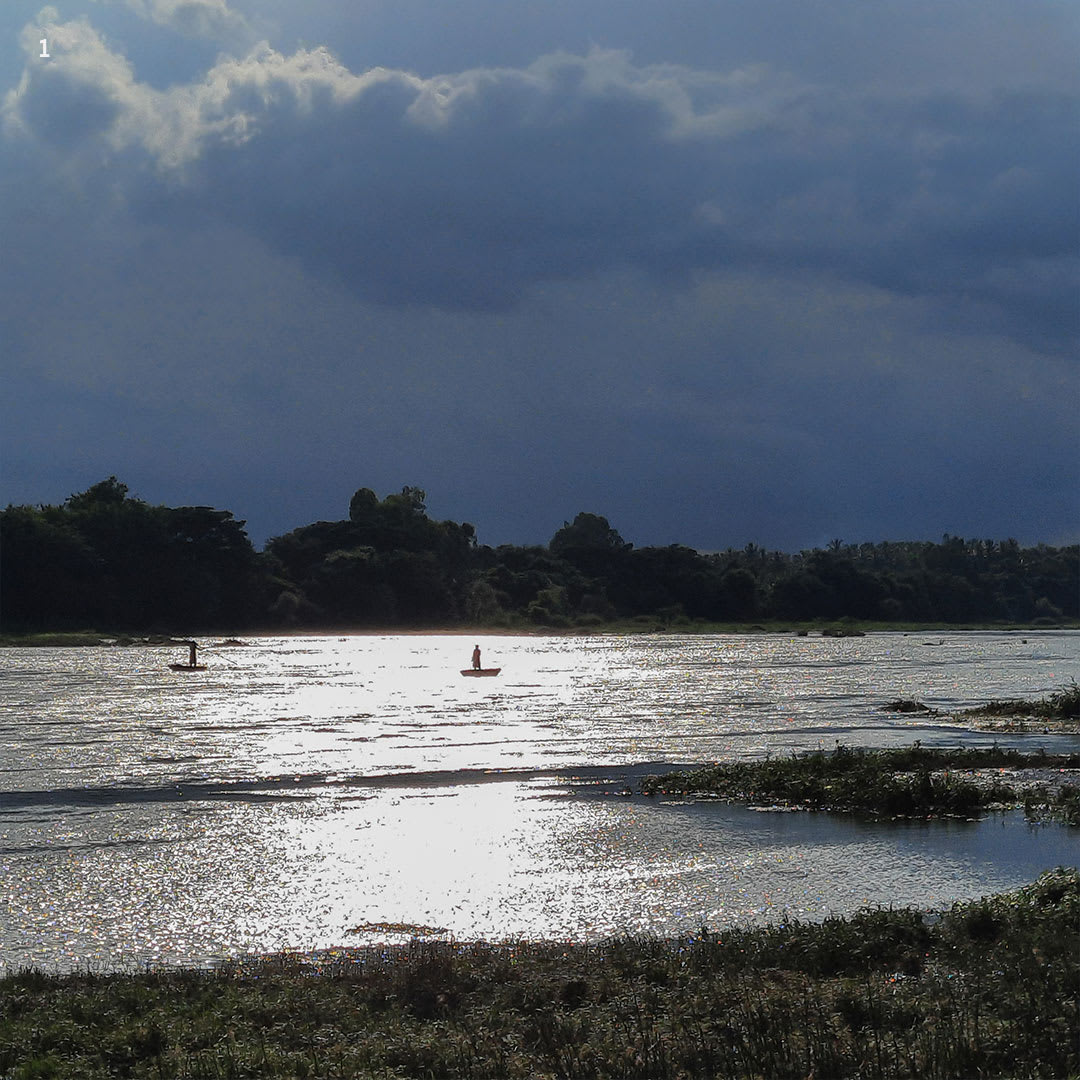 Listen to this article
•
15:34 min
Listen to this article
•
15:34 min
A lone painted stork flies above Siddhu, a 63-year-old fisherman, while he slings his gill net gracefully into the blue-green waters of the Cauvery River. He gently steers his saucer-shaped bamboo coracle forward with a paddle. The river is just half a kilometre wide here. As it flows gently downstream, Sidhu glides along with his old, torn nylon net, drifting to his favourite fishing spots.
A resident of Sri Rangarajapura, a village 40 km from Mysore, Siddhu has been fishing here since he was a young lad. Thirty-five years back, there was so much sand in the river that he and his father would wade in the water with pieces of cloth serving as nets and come back with an abundant catch. Now, the river is deeper due to erosion from sand mining, and fish are hard to come by, even with coracles and woven nets.
(1) The Cauvery is an east-flowing rain-fed river that goes through Karnataka, Kerala, and Tamil Nadu. It is home to several endangered creatures, such as smooth-coated otters (2) and mahseer. Photos: Nisarg Prakash
Cover photo: The Cauvery supports several small communities of landless fishers whose livelihoods depend on the fish from the river. Photo: Malligarjunan G/Shutterstock
Dwindling fish population
Siddhu moves along the course of the river for a couple of hours before returning to shore. His weathered face shows a flicker of frustration when he pulls up the last section of his net. The net is empty. There will be no fish today.
Most of Sri Rangarajapura’s residents are either farmers or fishers. Of 200 families, 20 fish for a living and have done so for generations. “But no fisherman today wants his son to continue in this occupation,” says Siddhu. The fish population is dwindling in the Cauvery. Catla and rohu — major native carp species and the most lucrative — were once abundant, but not anymore. Fishers struggle to support their families. Yet, many people in Sri Rangarajapura and neighbouring villages continue to fish for a living. Few villagers have more than a high school education; the only alternative for most is daily wage jobs.
As their lives have become more uncertain and difficult over the last decade (since around 2010), many fishers along the Cauvery focus blame on an unlikely villain: the smooth-coated otters. Native to the river and much of the Indian subcontinent, these otters are now listed as “Vulnerable” on the IUCN Red List. Fishers see otters as a threat as they vie for the same dwindling fish resources.
Unlikely villains
Otters are intelligent creatures. With declining fish populations in the Cauvery, they have learnt that sometimes the quickest way to a meal is to take fish from a fisherman’s net. Otters are generally shy, and though they are spotted frolicking on riverbanks, they avoid direct contact with humans. They will discreetly rip holes in fishing nets underwater to reach the fish. When fishers pull up their nets, their catch is gone, and their nets are damaged and torn.
Conflict between humans and other animals is a story as old as time. Today, it is a worldwide problem, affecting ranchers and wolves in the United States, villagers and elephants in China, or farmers and bears in Europe. In India, with its growing population, habitat degradation, and development encroaching on wildlife spaces, human-animal conflict is common and has taken a toll on tigers, elephants, and people.
A 2021 report by the United Nations Environmental Program and World Wildlife Fund refers to human-wildlife conflict as “one of the greatest threats to wildlife species”. But along the Cauvery, where rumours of the illegal killing of otters abounds, this threat greatly impacts the lives and livelihoods of local fishers.

Empty nets
Shivling Gowda, head of a large fishing community in KRS North Bank near the famed Krishna Raja Sagar (KRS) Dam, says their nylon nets only last 3-4 months as both otters and catfish destroy them. The Karnataka Department of Fisheries gives fishers loans to buy new nets every two years. Bhavani CN, Assistant Director of Fisheries at T Narasipura, says nylon nets do not tear easily. But Gowda, like many other fishers, complains about the poor quality of government-provided nets. “It’s hard to make a living with torn nets,” grumbles Rahman, a 30-year-old fisherman from Gargeshwari town, a few kilometres south of Sri Rangarajapura.
Sitting atop his bike at the edge of town near a flight of stone steps leading to the river, Rahman says, “When we leave the nets overnight in the river and find them empty in the morning, it is very upsetting.” Like many other fishers, he tries to adapt. “I’ve stopped buying nets,” he says. He shows a hook and line. “I manage with this,” he says. “Sometimes I get fish immediately.”

Extreme alternatives
Others have embraced more extreme methods of coping. Rather than buy nets and spend hours on the river for a low catch, they resort to dynamite fishing, an illegal practice that involves lighting a dynamite stick and quickly throwing it into the river. There it explodes, leaving a wake of carcasses of fish and other aquatic animals, which are sold to restaurants.
“Some do it right behind the fisheries office,” Rahman says angrily. “The sound is so loud. Why can’t they stop them?” In certain towns such as Mahadevapura and Bannur, where dynamiting is rumoured to be rampant, many people have reportedly lost fingers or arms to the blasts.
The dynamite also kills many juvenile carp raised in hatcheries and released in places with little human activity. They are meant to help the Cauvery’s fish population and its fishers but don’t get a chance to grow into adults.
While dynamite fishing generates an easy income for the unscrupulous, for many honest fishers like Rahman, the daily catch keeps getting smaller, making it difficult for them to afford the Rs 1,500 annual fishing license.
In their desperation, villagers along the Cauvery, even as they abhor the violence of dynamite fishing, wonder if something can be done about the vulnerable smooth-coated otters that damage their nets. Some fishers, they say, set traps to kill the otters.
Back in Sri Rangarajapura, Siddhu and his son Harisha are unwilling to do that.
They just keep adapting to their situation. “We used to fish only at night,” says Harisha, picking up the family’s hole-ridden net from the banks of the Cauvery. Siddhu remembers a time when otters were in plenty before the poaching began, but they weren’t a problem as there was plenty of fish in the river. Now, when their nets are left overnight, otters tear them and steal all the fish. So, they fish for a few hours in the early mornings and evenings. They have also started to use fish cages to protect their catch from otters.
Siddhu helps Harisha set the net out to dry. Officials need to do something about the otters, he opines, but understands that they, too, need to survive. And he senses that while the threat of the otters is real, there are many other issues that impact their livelihood — not all of them as obvious to the fishers of the Cauvery as the holes in their nets.
“Earlier, we would fish, cook, and eat. Life was simple,” Siddhu laments. “Now there are too many problems. A fisherman’s life has become very unstable.”
This story is the first of a three-part series on the Cauvery river ecosystem. In the second instalment, read how pollution and global warming are adversely impacting Cauvery’s water quality and its native fish populations.
The reporting for this series was supported by the International Women's Media Foundation's Howard G. Buffet Fund for Women Journalists.












